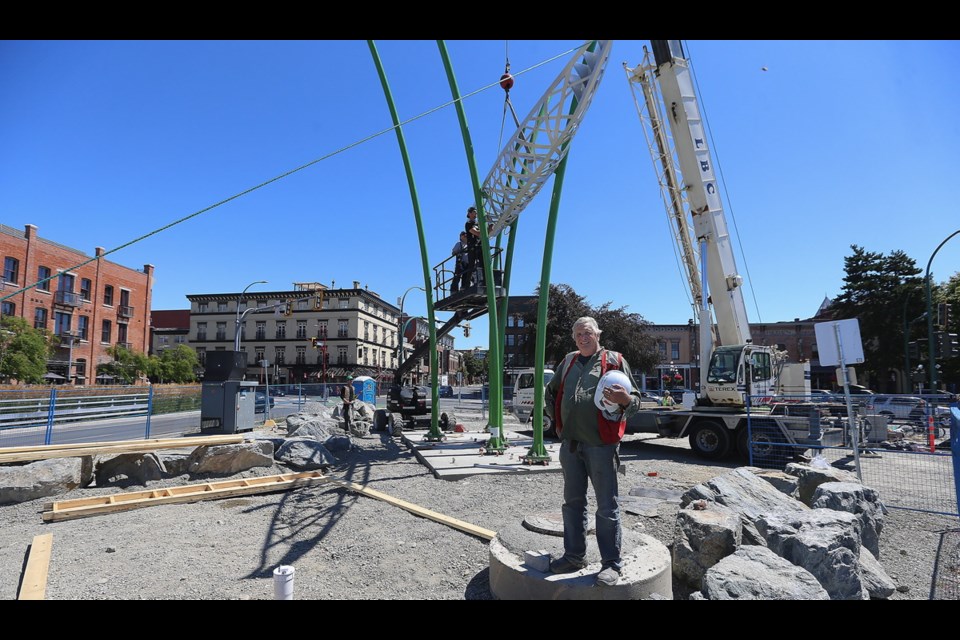Illarion Gallant cups his hands and hollers to the men in the hardhats, the ones oh-so-slowly craning his canoe sculpture into place: “You guys have got it backward!”
The artist is joking, having some fun with the crew carefully erecting his giant installation at the downtown end of the Johnson Street Bridge. It wouldn’t be the first time a boat-as-art piece had pointed the wrong way, though: New York’s Museum of Modern Art once hung Henri Matisse’s Le Bateau upside down for 47 days.
Happily, there were no mistakes Wednesday, a relief considering the precision needed to reassemble the work known as Commerce Canoe. You know the one: it soared above Bastion Square from 2008 until last October, an aluminum boat suspended in five red-topped green reeds.
City council decided last year to move Commerce Canoe to its new home, a triangular island at the junction of Wharf, Pandora and Johnson, after staff warned that the cost to put in the interactive artwork originally envisioned for that spot — orcas re-imagined as 11 stylized surfboards — would likely blow past the $250,000 budgeted. The orca idea, already controversial, sank.
Gallant can tell you all about controversial. It comes with the territory when you create public art. Artists who are used to exhibiting only in hushed, church-like galleries would have the vapours were their works subjected to the bluntly honest, often voluble assessments of people who stumble across art in the open air.
Note that even before Commerce Canoe was installed in 2008, some balked at the idea of placing modern art in an historic square. After it was announced that Gallant had won a 20-entry competition for the commission, a letter to the Times Colonist groused: “Was it a decision based on money saved or were the other 19 submissions that bad?”
Letters to the editor are a favourite place for critics to have their say about public art, particularly when the art is paid for by the public. When Mowry Baden’s $120,000 abstract sculpture Pavilion, Rock and Shell was unveiled in front of the Save-on-Foods Memorial Centre in 2003, one wag suggested dragging it to the airport and renaming it Cessna, Rock and Fog.
Similarly, when Jay Unwin’s marble Truth and Harmony appeared outside the Victoria police station in 1996, a reader called it “that block of cement with the bare bottoms.” In 2006, a writer was aghast that a statue of Swans Hotel owner Michael Williams held a drink in its hand. Public art turns everyone into an expert in the same way the pandemic has turned us all into epidemiologists.
Sometimes, the vision for public art doesn’t meet the reality. After a 55-metre totem pole, the world’s tallest, was erected at the entrance to the Inner Harbour to mark the 1994 Commonwealth Games, Victorians were dismayed to learn that thick guy wires and steel collars were needed to hold it aloft, and that authorities mandated a flashing red light on top so that float planes didn’t smack into it.
The Globe and Mail described it thusly: “From the front steps of the Empress Hotel across the harbour, the new totem pole looks like the giant flag poles that grace Husky gas stations, minus the flag.” It was shortened in 1997, which felt like cutting the head off the Mona Lisa because it didn’t fit the frame.
People do not always treat open-air art with the reverence the artist might have hoped, either. The Inner Harbour bronze sculpture The Homecoming, featuring a little girl rushing to greet a returning sailor, occasionally pops up in tourist photos in which a woman thrusts a hand into the bronze child’s face while tilting forward so the sailor’s outstretched hand is cupping a breast. Likewise, people used to send Gallant photos of 3 a.m. drunks climbing Commerce Canoe.
He shrugs. After decades of public art — among his many Victoria-area works are the metal flowers outside Victoria International, the granite avocados outside the Hotel Grand Pacific, a sculpture high up on the outside of a 15-storey building in the 800-block of Yates Street and, overlooking Patricia Bay on the north side of the airport, a striking memorial to the 179 fliers who died while training there during the Second World War — it’s part of the package.
As for Commerce Canoe’s new home, he’s happy. He designed it with the harbour in mind, he said. The open setting by the bridge fits. “I liked it in Bastion Square, but I thought that it was cramped.”
The relocation was paid for with vendor fees collected from the Bastion Square Market. The same source will fund a welcoming pole in the square.
In some ways, showing the piece in a new setting, having it seen from a new vantage point, is like presenting it to the world all over again — and he loves seeing people run across a piece for the first time.
“You know what’s cool? Seeing people’s visceral reaction,” he says. “That’s honest. That’s authentic.” That’s the real world. That’s public art.



